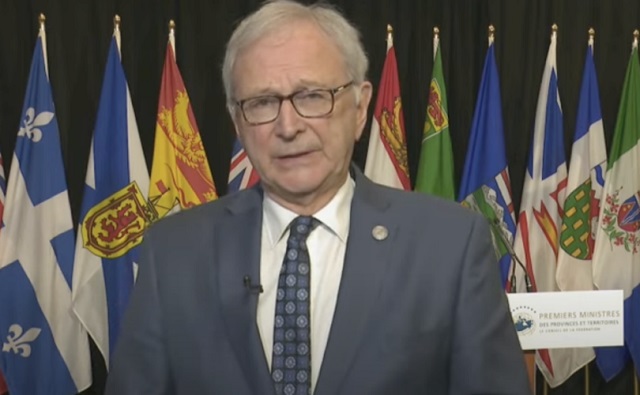Opinion
New Brunswick premier bans ‘sex-ed’ group from schools after presentation on porn, immoral sex acts

New Brunswick Premier Blaine Higgs
From LifeSiteNews
Sharing slides of a presentation given by a third-party group to New Brunswick school children that contained questions about pornography, masturbation and ‘anal’ sex, Premier Blaine Higgs said he is ‘furious’ and that the group has been banned, ‘effective immediately.’
Once again, New Brunswick Premier Blaine Higgs is showing Canadian politicians how to effectively advocate for common sense socially conservative policies. On May 24, he tweeted out a photograph of a slide from a sex education presentation given in a New Brunswick school. The slide featured red lips closing on a lollipop, the title “Thirsty For The Talk,” and the questions: “Is it normal to watch porn like people watch TV series?”; “Do girls masturbate?” and: “Is it good or bad to do anal?”
Premier Higgs posted his response:
A number of concerned parents have shared with me photos and screenshots of clearly inappropriate material that was presented recently in at least four New Brunswick high schools.
To say I am furious would be a gross understatement.
This presentation was not part of the New Brunswick curriculum and the content was not flagged for parents in advance. My office has been told by Department of Education officials that this was supposed to be a presentation on HPV.
However, the group shared materials well beyond the scope of an HPV presentation. The fact that this was shared shows either improper vetting was done, the group misrepresented the content they would share … or both.
This group will not be allowed to present again at New Brunswick schools, effective immediately.
Our government will have further discussions about whether additional rules about third-party presentations need to be updated.
Children should be protected, and parents should be respected.
I want parents to know that we are with you. We will continue to make decisions based on the principle that parents need to be aware of what is happening at schools, so they can make informed parenting decisions.
Do you think we need stronger rules about third-party presentations in our schools? I want to hear directly from you. Take our survey by clicking here:
Presentations like this – and indeed, presentations containing far more graphic material – are common in Canadian public schools. Plenty of schools actually feature in-house content that is substantially worse than this. But every time a debate about explicit, how-to sexual content in schools erupts, progressive activists and politicians dodge the issue by retreating to vagueness. Instead of defending the idea of an activist group like Planned Parenthood coming in to talk to students about why anal sex is just fine, they insist that this content is essential for “inclusion” and “tolerance” while scrupulously avoiding the specifics. Inevitably, most of the press coverage of the debate fails to include the specifics of what actually upset parents in the first place, and instead presents objectors as opposed to common sense progressive educational policies.
When the explicit content in question is described, however, progressives are denied the opportunity to defend their policy of encouraging and introducing fringe sex acts to children in vague, friendly, liberal-sounding buzzwords. Last year, for example, Planned Parenthood got caught handing out graphic “ABC” sex cards to students as young as 14 that explained, for example, how they could engage in “yellow and brown showers” (urinating and defecating on their partners). Plenty of other dangerous and immoral sex acts are encouraged, with Planned Parenthood’s presentation stating that each sexual urge must be “affirmed” – the amorality, in short, was up front.
But when the sex cards were covered in a handful of press outlets, parents were outraged the Saskatchewan government got involved. Planned Parenthood is now banned from presenting in Saskatchewan schools (although it was never explained why they were invited to do so in the first place). Planned Parenthood was reportedly confused by this decision, as they didn’t see the problem with the content they had distributed – but the only reason they were denied access to Canadian kids is because the graphic sexual information they were distributing was exposed publicly.
Premier Blaine Higgs appears to have realized that to implement common sense policies, exposing what is actually being taught in public schools is the only way forward. Progressives cannot be allowed to hide behind buzzwords like “toleration” and “inclusion.” Politicians and activists – including the prime minister – who wish to defend this content should be made to defend specifics, and the only way to force them to do that is to show the public what the kids are being taught in schools.
2025 Federal Election
Highly touted policies the Liberal government didn’t actually implement

From The Audit
State capacity is the measure of a government’s ability to get stuff done that benefits its population. There are many ways to quantify state capacity, including GDP per capita spent on health, education, and infrastructure versus outcomes; the tax-to-GDP ratio; judicial independence; enforcement of contracts; and crime rates.
But a government’s ability to actually implement its own policies has got to rank pretty high here, too. All the best intentions are worthless if, as I wrote in the context of the Liberal’s 2023 national action plan to end gender-based violence, your legislation just won’t work in the real world.
The Audit is a reader-supported publication.
To receive new posts and support my work, consider becoming a free or paid subscriber.
So I thought I’d take a look at some examples of federal legislation from the past ten years that passed through Parliament but, for one reason or another, failed to do its job. We may agree or disagree with goals driving the various initiatives, but government’s failure to get the work done over and over again speaks to a striking lack of state capacity.
The 2018 Cannabis Act (Bill C-45). C-45 legalized recreational cannabis in Canada, with a larger goal of regulating production, distribution, and consumption while reducing illegal markets and protecting public health. However, research has shown that illegal sales persisted post-legalization due to high legal prices and taxation. Studies have also shown continued use among children despite regulations. And there are troubling indicators about the overall impact on public health.
The 2021 Canadian Net-Zero Emissions Accountability Act (Bill C-12). The legislation aimed to ensure Canada achieves net-zero greenhouse gas emissions by 2050 by setting five-year targets and requiring emissions reduction plans. However, critics argue it lacks enforceable mechanisms to guarantee results. A much-delayed progress report highlighted a lack of action and actual emissions reductions lagging far behind projections.
The First Nations Clean Water Act (Bill C-61) was introduced in late 2024 but, as of the recent dissolution of Parliament, not yet passed. This should be seen in the context of the Safe Drinking Water for First Nations Act (2013), which was repealed in 2021 after failing to deliver promised improvements in water quality due to inadequate funding and enforcement. The new bill aimed to address these shortcomings, but a decade and a half of inaction speaks to a special level of public impotence.
The 2019 Impact Assessment Act (Bill C-69). Passed in 2019, this legislation reformed environmental assessment processes for major projects. Many argue it failed to achieve its dual goals of streamlining approvals while enhancing environmental protection. Industry groups claim it created regulatory uncertainty (to put it mildly), while environmental groups argue it hasn’t adequately protected ecosystems. No one seems happy with this one.
The 2019 Firearms Act (Bill C-71). Parts of this firearms legislation were delayed in implementation, particularly the point-of-sale record keeping requirements for non-restricted firearms. Some provisions weren’t fully implemented until years after passage.
The 2013 First Nations Financial Transparency Act. – This legislation, while technically implemented, was not fully enforced after 2015 when the Liberal government stopped penalizing First Nations that didn’t comply with its financial disclosure requirements.
The 2019 National Housing Strategy Act. From the historical perspective of six years of hindsight, the law has manifestly failed to meaningfully address Canada’s housing affordability crisis. Housing prices and homelessness have continued their rise in major urban centers.
The 2019 Indigenous Languages Act (Bill C-91). Many Indigenous advocates have argued the funding and mechanisms have been insufficient to achieve its goal of revitalizing endangered Indigenous languages.
The 2007 Public Servants Disclosure Protection Act (PSDPA). Designed to protect whistleblowers within the federal public service, the PSDPA has been criticized for its ineffectiveness. During its first three years, the Office of the Public Sector Integrity Commissioner (OPSIC) astonishingly reported no findings of wrongdoing or reprisal, despite numerous submissions. A 2017 review by the Standing Committee on Government Operations and Estimates recommended significant reforms, but there’s been no visible progress.
There were, of course, many bills from the past ten years that were fully implemented.¹ But the failure rate is high enough that I’d argue it should be taken into account when measuring our state capacity.
Still, as a friend once noted, there’s a silver lining to all this: the one thing more frightening than an inefficient and ineffective government is an efficient and effective government. So there’s that.
The fact that we’re still living through the tail end of a massive bout of inflation provides clear testimony that Bill C-13 (COVID-19 Emergency Response Act) had an impact.
For the full experience, upgrade your subscription.
Courageous Discourse
Europe Had 127,350 Cases of Measles in 2024

 By Peter A. McCullough, MD, MPH
By Peter A. McCullough, MD, MPH
US Mainstream Media Maintains Myopic Focus on Less than 1000 Cases
As the measles story in the US continues to unfold with reporting of a few cases here and there come in through mainstream media, I wondered about measles in Europe.
The WHO casually reported that the Europe Region had 127,350 cases in 2024.
According to an analysis by WHO and the United Nations Children’s Fund (UNICEF), 127 350 measles cases were reported in the European Region for 2024, double the number of cases reported for 2023 and the highest number since 1997.
Children under 5 accounted for more than 40% of reported cases in the Region – comprising 53 countries in Europe and central Asia. More than half of the reported cases required hospitalization. A total of 38 deaths have been reported, based on preliminary data received as of 6 March 2025.
Measles cases in the Region have generally been declining since 1997, when some 216 000 were reported, reaching a low of 4440 cases in 2016. However, a resurgence was seen in 2018 and 2019 – with 89 000 and 106 000 cases reported for the 2 years respectively. Following a backsliding in immunization coverage during the COVID-19 pandemic, cases rose significantly again in 2023 and 2024. Vaccination rates in many countries are yet to return to pre-pandemic levels, increasing the risk of outbreaks.
Many regions in Europe have lower rates of measles vaccination than the goal of 95%.
Less than 80% of eligible children in Bosnia and Herzegovina, Montenegro, North Macedonia and Romania were vaccinated with MCV1 in 2023 – far below the 95% coverage rate required to retain herd immunity. In both Bosnia and Herzegovina and Montenegro the coverage rate for MCV1 has remained below 70% and 50% respectively for the past 5 or more years. Romania reported the highest number of cases in the Region for 2024, with 30 692 cases, followed by Kazakhstan with 28 147 cases.
The WHO Report does not mention adjudication of hospitalizations or deaths. Presumably hospitalization of healthy kids is routine for contagion control. So if measles is so common and presumably well-handled by Europe, why is it such a big deal in the United States? Don’t look for Sanjay Gupta or Anderson Cooper to tell you that a similar size region and population handles >100K cases per year without much fanfare.
Peter A. McCullough, MD, MPH
President, McCullough Foundation
FOCAL POINTS (Courageous Discourse) is a reader-supported publication.
To receive new posts and support my work, consider becoming a free or paid subscriber.
Please subscribe to FOCAL POINTS as a paying ($5 monthly) or founder member so we can continue to bring you the truth.
Subscribe to FOCAL POINTS (Courageous Discourse).
For the full experience, upgrade your subscription.
-

 Alberta2 days ago
Alberta2 days agoOwner sells gas for 80 cents per litre to show Albertans how low prices ‘could’ be
-

 International2 days ago
International2 days agoTrump’s ‘Golden Dome’ defense shield must be built now, Lt. Gen. warns
-

 2025 Federal Election1 day ago
2025 Federal Election1 day agoMORE OF THE SAME: Mark Carney Admits He Will Not Repeal the Liberal’s Bill C-69 – The ‘No Pipelines’ Bill
-

 Break The Needle1 day ago
Break The Needle1 day agoWhy psychedelic therapy is stuck in the waiting room
-

 Automotive1 day ago
Automotive1 day agoTrump Must Act to Halt the Tesla Terror Campaign
-

 2025 Federal Election1 day ago
2025 Federal Election1 day agoThree cheers for Poilievre’s alcohol tax cut
-

 2025 Federal Election1 day ago
2025 Federal Election1 day ago‘Coordinated and Alarming’: Allegations of Chinese Voter Suppression in 2021 Race That Flipped Toronto Riding to Liberals and Paul Chiang
-

 Alberta1 day ago
Alberta1 day agoEnergy sector will fuel Alberta economy and Canada’s exports for many years to come









